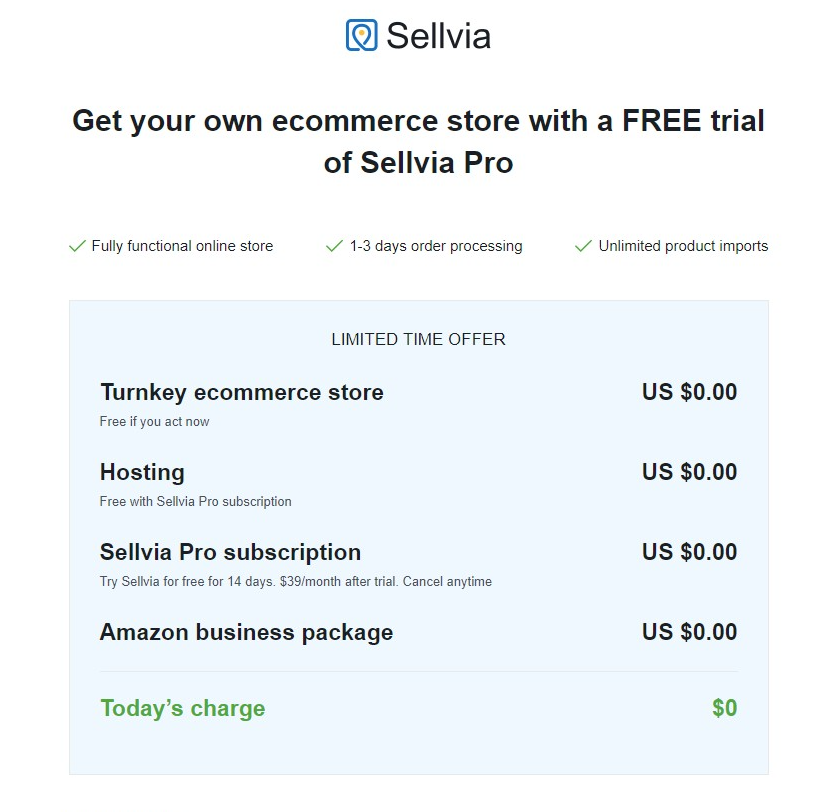Top Info For Selecting Sellvia Shopify Dropshipping Services
Top Info For Selecting Sellvia Shopify Dropshipping Services
Blog Article
How To Evaluate The Customer Support And Service Features Of An Amazon Seller Or Shopify Service For Dropshipping To Us Markets
Assessment of support and customer service for dropshipping within the U.S. marketplace on Amazon Seller Shopify, WordPress (WooCommerce), or WordPress is critical as customer satisfaction is dependent on promptness, effective communication, reliable issue resolution, and so on. How can you evaluate the support and customer support capabilities.
1. Amazon Seller
Amazon's Customer Services Policies
Amazon has strict rules regarding the manner and frequency you are allowed to communicate with clients. You're expected to respond to customer queries within 24 hours, which can be a bit demanding.
FBA sellers will save time by using Amazon's FBA Program, which handles returns, refunds, and customer queries. Merchant Fulfilled Network requires you to manage returns, refunds and customer inquiries on your own. This requires robust customer service procedures.
Support for Sellers:
Seller Support Service: Amazon offers seller support through its Seller Central platform. On the Seller Central platform, you can have access to FAQs, resources and live chat as well as email support. These services can help with issues like problems with orders accounts management or questions.
Amazon makes sellers accountable by measuring metrics such Order Defects Rate (ODR), response times and performance metrics. Poor customer support can cause account cancellations. So, it is important that you offer reliable customer support.
Steps to Assess Amazon Sellers:
Examine Responsiveness requirements: Review Amazon’s requirements for customer responses times and make sure you have the right tools or bandwidth (such as automated systems) to meet these.
Return Handling: If you're using MFN, make sure that your fulfillment partner or supplier has support for returns. Amazon will handle returns if your store uses FBA. But it's important to be aware of any issues that could be a problem to ensure the complete satisfaction of customers.
Customer Service Tools Ensure you know how to use the tools available in Seller Central for disputes, refunds, or general support. Consider third-party tools if you require additional support to meet Amazon's strict response requirements.
2. Shopify
Apps that incorporate customer service:
Shopify integrates with Gorgias Zendesk Re and Re and Re, which all provide customer service applications.
It provides dashboards that allow users to manage their inquiries via different channels, including email, chat and social media.
Automated communication: Shopify offers a variety of applications that provide automated replies, chatbots and FAQs. It can assist customers find quick answers to their inquiries.
Shopify offers a wide range of customized messaging options that include email confirmations, abandon cart emails and messages to follow-up with customers. This helps build customer loyalty and satisfaction.
Notifications and Tracking Orders
Real-Time Notifications: Shopify can send real-time messages to customers with regards to their order status, updates on shipping as well as delivery tracking. Transparency reduces the number of inquiries from customers.
Customer Order Status Page: Shopify lets customers view their order status on the order status page, eliminating the requirement to call support.
Evaluation Steps for Storeify
Examine the Apps Available. Check out customer service applications such as Gorgias which offer omnichannel help and directly integrate into Shopify.
Shopify's Customer Communication Flexibility Shopify offers email templates that can be customized with automatic responses and chatbots that are timely and useful for customer interaction.
After-Sale Customer Support: Find out whether the platform offers solutions for after-sales customer support like easy refund processing via the use of third-party applications or return labels. Shopify's integrations can simplify customer satisfaction and returns.
3. WordPress (WooCommerce),
Customer Service Plugins
WooCommerce offers a variety of live chat plugins and help desks that you could incorporate directly into your site. They include Zendesk and Zendesk Help Scout. These tools offer live chat, knowledge bases, and tickets for customer service.
Automated Chatbots. For fast responses you can utilize AI-based plugins for chatbots, like Tidio or ChatBot, that automate interactions with customers, supporting customers with questions that are common to them and improving their response time.
Email Notifications WooCommerce lets customers customize emails regarding the confirmation of their order as well as delivery and shipping. This provides them with a better understanding of their orders.
Returns tracking and tracking orders:
Order Tracking Plugins, such as TrackShip allow customers to access the latest information about their order through your website. This reduces the number of inquiries related to the order.
Returns and refunds: WooCommerce provides customizable policies for refunds and returns, and even plugins such as RMA from WooCommerce can help automate returns. This feature lets you handle refunds and returns in an efficient way.
WooCommerce Evaluation Steps
Explore chatbot plugins, live chat and ticketing. WooCommerce's Help Scout and LiveChat offer several customer support options.
Automated Communication and Tracking: Make order tracking and status updates easy to access for customers, as this will help reduce the number of inquiries regarding order status. Use plugins like TrackShip for automatic tracking notifications.
WooCommerce provides you with flexibility when setting your policies for refunds and returns. Use plugins for return handling to make the process easier for customers and improve their experience. Follow the pro Sellvia for more advice including sale business online, build an online shop, dropshipping website, online selling items, amazon commerce, open online business, ecommerce store, winning products, online business for sell, store dropshipping and more.
What Is The Best Way To Measure Customization, Scalability And Efficiency
Dropshippers that use Amazon Seller, Shopify and WordPress (WooCommerce), must look at scaleability and customization. Each platform comes with various levels of customization, flexibility, and potential for growth. This article will provide a method to evaluate each of these aspects for a US-based dropshipping business.
1. Amazon Seller
Scalability:
Marketplace Exposure and Infrastructure - Amazon's vast U.S. client base, its fulfillment infrastructure (Fulfillment By Amazon, or FBa), and the company's reputation have allowed it to grow. Dropshipping is a less-work for dropshippers in terms of creating traffic but it also implies greater competition, and less control over branding.
Fulfillment by Amazon: Sellers can leverage Amazon's logistics system for packaging, storage and shipping. FBA however, is not the norm of pure dropshipping. This means that sellers might have to choose between Amazon's Fulfillment and managing third party dropship partnership.
Amazon has strict guidelines regarding dropshipping. The company also limits certain types of activities, like sending directly to a different retailer. Amazon also regulates the way listings are displayed, which may affect branding and product differentiation.
Customization:
Amazon does not allow customization for its store. This limits brand personalization, and also impacts users' experience. Sellers are limited in their branding options since they cannot customize the layouts or colors.
Branding Tools for Registered Brands: Amazon's Brand Registry offers tools like Enhanced Brand Content (EBC) and A+ Content for sellers with trademarks registered with the company. These tools allow for custom content sections and images as well as detailed descriptions for product listings. They can help build brand awareness.
Amazon has a limited say in pricing, however it offers discounts, coupons and lightning deals. Prices can be affected by the competitive market environment, as many customers just compare products in relation to price.
Amazon Sellers: How to Evaluate their Performance
Review Fulfillment Options: Determine the possibility that Amazon FBA or Merchant Fulfilled Network (MFN) works better for your dropshipping strategy. Ensure your dropshipping partners can comply with Amazon's specifications in the event you decide to use MFN.
Consider Brand Registry.
Analyze Pricing Strategy: Understanding Amazon's constantly changing price environment will help you determine whether your business can maintain profit margins while staying in the market.
2. Shopify
Scalability:
Shopify's pricing is based on a tiered model. Customers can begin with the basic plan, before moving up to more advanced plans, with higher volumes of transactions and more features. They also have more customization options. Shopify Plus for enterprise-level companies provides advanced features to large volume suppliers.
Dropshipping Apps and Fulfillment Networks: Shopify integrates easily with dropshipping platforms, such as Oberlo, Spocket, and Modalyst that allow sellers to add products and fulfill orders in real-time as their numbers grow. Shopify also integrates with fulfillment platforms like Shopify Fulfillment Network or ShipBob to provide scalable logistic support.
Third-Party Integrations Shopify has an extensive app marketplace that allows you to incorporate new functions as your organization grows. Many apps are accessible to help dropshippers build their business. They include analytics, marketing customer support, and management of inventory.
Customization:
Themes and Store Design: Shopify offers customizable themes which allows sellers to design customized storefronts. Dropshippers are able to modify the themes in terms of design, color, and design.
Shopify Liquid's programming language is an effective tool for app integration as well as advanced modifications. If you're experienced with development or have the help of an experienced developer, it is possible for more sophisticated customizations. Shopify's API lets you integrate custom applications or connect with third-party services.
Shopify can customize the user experience: Shopify provides a range of tools for personalization, including product suggestions, loyalty programs, custom email flows, and many more, to help dropshippers provide customers with a personalized shopping experience U.S. clients.
Assessment Steps for Shopify:
Review Your Growth Expectations Find out if your current Shopify plan has the necessary upgrades and features. Examine Shopify's scalability options, such as multi-store support on Shopify Plus.
Explore Customization Options: Check out various themes, and then consider customizing needs for your brand. Determine if you need developers to develop custom integrations or features.
App Integrations for Dropshipping : Look into dropshipping software that is that are compatible with Shopify. Also, make sure that they can be scaled smoothly for managing the inventory and order processing.
3. WordPress (WooCommerce)
Scalability:
Flexible Hosting Options: WooCommerce is self-hosted, meaning the capacity of your site is dependent on your web hosting service. Managed WordPress hosts (e.g. WP Engine, Kinsta) can handle websites with high traffic. However, the costs will increase as your site grows.
Control over the infrastructure - With WooCommerce you can customize the configuration of your server to match the increasing orders or traffic. This level gives the most control for advanced dropshippers that anticipate huge sales volumes.
Plugins to Automate and Fulfillment: WooCommerce offers plugins that automate processes, such as AliDropship for WooCommerce, Printful for WooCommerce, and Oberlo. These plugins will help you speed up order processing, inventory updates and other features that are operational.
Customization:
WooCommerce's customizable designs and themes are offered in thousands of free or premium themes. Many of these are fully customizable. By utilizing CSS and HTML knowledge it is possible to create a unique brand experience.
WooCommerce's plugin system offers almost unlimited possibilities for customization. Users can add plugins to support SEO as well as loyalty programs, abandoned cart recovery, and many other features that can enhance the customer experience. This is particularly useful for dropshipping in the US which is where conversion optimization and targeted marketing are essential.
The open-source nature of WooCommerce allows users to customize the code layer. They can adjust the backend functionality, develop custom plugins and design an individualized user experience. The platform's flexibility lets you to personalize everything from product pages to checkout flow.
Evaluation Steps for WooCommerce:
Hosting Scalability: Choose a hosting provider capable of handling the increased volume of traffic, when your dropshipping business expands. Make sure that the hosting plan you choose has features that can be scaled, like bandwidth or storage.
Review the theme and plugin customization: Evaluating WooCommerce themes, and plugins that allow customization requirements for U.S. Marketing strategies. Determine which plugins facilitate dropshipping processes.
Consider Code-Level Modifications If you've got complex requirements for customization, be sure that you have the necessary resources (developer access and budget) for ongoing customizations. Follow the most popular Sellvia reviews for blog advice including start a dropshipping business, items that are trending, sell via, good items to dropship, ecommerce solution, online commerce store, ecommerce retailer, e business, ecommerce retailer, e commerce marketing and more. 